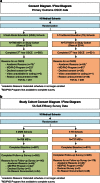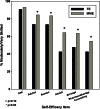Teaching Medical Students to Help Patients Quit Smoking: Outcomes of a 10-School Randomized Controlled Trial
- PMID: 26391030
- PMCID: PMC4720645
- DOI: 10.1007/s11606-015-3508-y
Teaching Medical Students to Help Patients Quit Smoking: Outcomes of a 10-School Randomized Controlled Trial
Abstract
Background: Early in medical education, physicians must develop competencies needed for tobacco dependence treatment.
Objective: To assess the effect of a multi-modal tobacco dependence treatment curriculum on medical students' counseling skills.
Design: A group-randomized controlled trial (2010-2014) included ten U.S. medical schools that were randomized to receive either multi-modal tobacco treatment education (MME) or traditional tobacco treatment education (TE).
Setting/participants: Students from the classes of 2012 and 2014 at ten medical schools participated. Students from the class of 2012 (N = 1345) completed objective structured clinical examinations (OSCEs), and 50 % (N = 660) were randomly selected for pre-intervention evaluation. A total of 72.9 % of eligible students (N = 1096) from the class of 2014 completed an OSCE and 69.7 % (N = 1047) completed pre and post surveys.
Interventions: The MME included a Web-based course, a role-play classroom demonstration, and a clerkship booster session. Clerkship preceptors in MME schools participated in an academic detailing module and were encouraged to be role models for third-year students.
Measurements: The primary outcome was student tobacco treatment skills using the 5As measured by an objective structured clinical examination (OSCE) scored on a 33-item behavior checklist. Secondary outcomes were student self-reported skills for performing 5As and pharmacotherapy counseling.
Results: Although the difference was not statistically significant, MME students completed more tobacco counseling behaviors on the OSCE checklist (mean 8.7 [SE 0.6] vs. mean 8.0 [SE 0.6], p = 0.52) than TE students. Several of the individual Assist and Arrange items were significantly more likely to have been completed by MME students, including suggesting behavioral strategies (11.8 % vs. 4.5 %, p < 0.001) and providing information regarding quitline (21.0 % vs. 3.8 %, p < 0.001). MME students reported higher self-efficacy for Assist, Arrange, and Pharmacotherapy counseling items (ps ≤0.05).
Limitations: Inclusion of only ten schools limits generalizability.
Conclusions: Subsequent interventions should incorporate lessons learned from this first randomized controlled trial of a multi-modal longitudinal tobacco treatment curriculum in multiple U.S. medical schools. NIH Trial Registry Number: NCT01905618.
Keywords: counseling; medical school curriculum; medical student behaviors; objective structured clinical examination; randomized controlled trial; tobacco dependence treatment.
Figures
Comment in
-
Training Future Physicians to Deliver Tobacco Cessation Treatment.J Gen Intern Med. 2016 Feb;31(2):144-146. doi: 10.1007/s11606-015-3560-7. J Gen Intern Med. 2016. PMID: 26747628 Free PMC article. No abstract available.
References
-
- Jamal A, Dube S, Malarcher A, Shaw L, Engstrom M, Office on Smoking and Health et al. Tobacco use screening and counseling during physician office visits among adults - national ambulatory medical care survey and national health interview survey, United States, 2005–2009. MMWR Morb Mortal Wkly Rep. 2012;61:38–45. - PubMed
-
- U.S. Preventive Services Task Force Counseling and interventions to prevent tobacco use and tobacco-caused disease in adults and pregnant women: U.S. Preventive services task force reaffirmation recommendation statement. Ann Intern Med. 2009;150(8):551–555. doi: 10.7326/0003-4819-150-8-200904210-00009. - DOI - PubMed
-
- Association of American Medical Colleges (AAMC). Physician behavior and practice patterns related to smoking cessation. Washington, DC: AAMC2007.
Publication types
MeSH terms
Associated data
Grants and funding
LinkOut - more resources
Full Text Sources
Other Literature Sources
Medical
Miscellaneous



